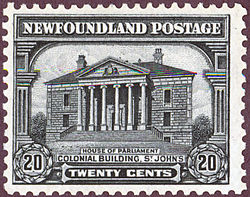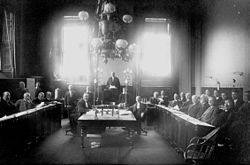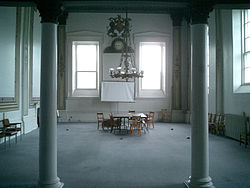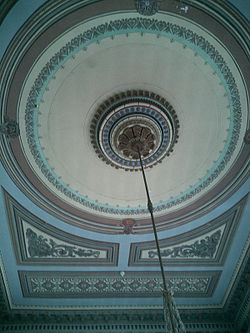- Colonial Building
-
Colonial Building 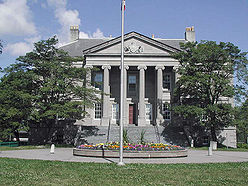
General information Architectural style Neoclassical Location Military Road
St. John's, NewfoundlandCountry Canada Construction started 24 May 1847 Cost £18,335 Design and construction Architect James Purcell Engineer Patrick Keough Colonial Building was the home of the Newfoundland government and the House of Assembly from January 28, 1850 to July 28, 1959. In 1974 it was declared a Provincial Historic Site.
In 1832 when the Colony of Newfoundland governed itself by representative government there was not a formal building assigned to house the legislature. The first home of the Legislature was a tavern and lodging house owned and operated by a Mrs. Travers. The stay was brief as in the legislature's haste and inexperience it forgot to vote approval for the funds to pay rent. For the next seventeen years they would meet in various temporary quarters. In 1846 an act was approved authorizing the construction of a Colonial Building as a permanent home.
On May 24, 1847 the cornerstone was laid by the Governor, Major-General Sir John Gaspar LeMarchant. The official opening of the Colonial Building took place on January 28, 1850 by Governor Lemarchant for the second session of the House's fourth general assembly.
Contents
Construction
James Purcell was the main architect and Patrick Keough was the contractor. Colonial Building, built in the style of neoclassical was constructed of white limestone specially imported from Cork, Ireland. The facade features a massive portico consisting of six ionic columns supporting an entablature triangular pediment. The pediment is decorated with the Royal Arms sculpted in deep relief. The interior hall is screened with ionic columns supporting a quadrangular lantern dome. the two legislative chambers, each with a ceiling height of twenty eight feet, are decorated with corinthian pilasters. The whole structure was built at a cost of £18,335.
In 1880 Alexander Pindikowski, a Polish fresco painter, then serving a 15-month prison sentence for forgery received a one-month reduction in his sentence for the immaculate fresco painting work he completed at both Colonial Building and Government House.
Worthy of note is the fact that the governing party had chosen to sit on the left side of the House of Assembly as opposed to the traditional right side of the speaker because that's where the heaters were located, and it was the warmest part of the house. To this day the ruling party of the Newfoundland and Labrador House of Assembly continue to sit on the left side of the speaker of the house.
Historic events
It was the site where responsible government was given Newfoundland in 1855. It was at this building that Newfoundland entered in the Commission of Government in 1934 and the location of the Newfoundland National Convention from 1946–1948 then in 1949 when Newfoundland entered into Confederation with Canada.
It was also the site of a number of political riots and disturbances. One of those was the public protest on April 5, 1932 for maladministration and corruption in government when all the windows were broken, doors smashed and furniture destroyed, which cost $10,000 to repair. The Prime Minister, Sir Richard Squires, barely escaped the building at that time.
The building was also the site of Newfoundland's first bank robbery, in 1850. Located in the basement of the Colonial Building was the Newfoundland Savings Bank and it was robbed of £413.[1]
On July 28, 1959 the provincial legislature had its last working session in the building before relocating to the newly completed Confederation Building on Prince Philip Drive.
Current tenants
The Department of Tourism, Culture and Recreation currently has its Provincial Historic Sites of Newfoundland and Labrador offices located in the Colonial Building. Since late-2005, there are also three other non-profit organizations operating from the Colonial Building, including the Museum Association of Newfoundland and Labrador (MANL), the Association of Newfoundland and Labrador Archives (ANLA), and The Newfoundland Historical Society.
References
External links
- History of the Colonial Building by the Provincial Archives of Newfoundland and Labrador
- Picture of the Colonial Building
Coordinates: 47°34′15.34″N 52°42′24.44″W / 47.5709278°N 52.7067889°W
Categories:- Buildings and structures in St. John's, Newfoundland and Labrador
- Legislative buildings in Canada
- Neoclassical architecture
- Houses completed in 1850
- Newfoundland and Labrador House of Assembly
Wikimedia Foundation. 2010.

